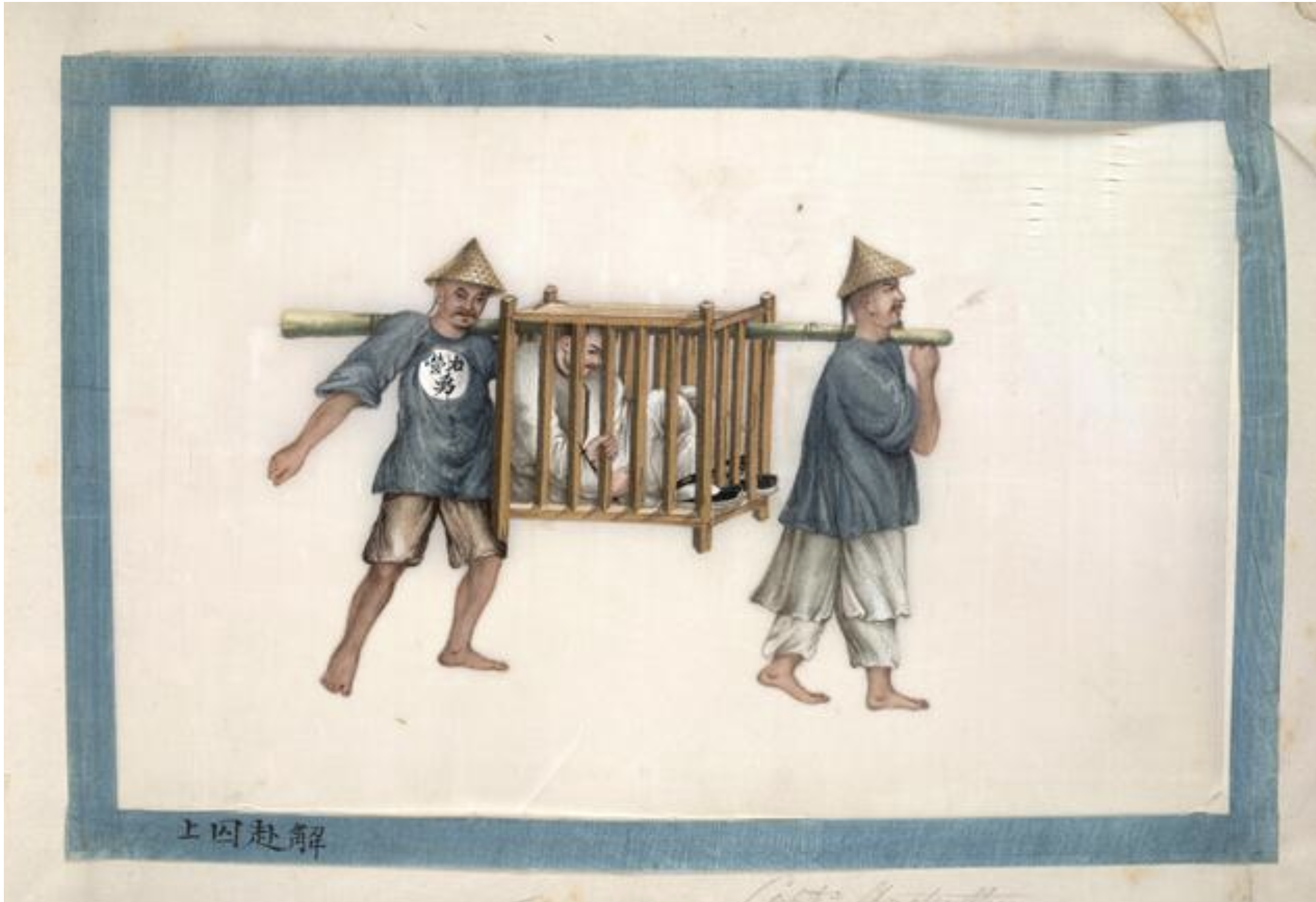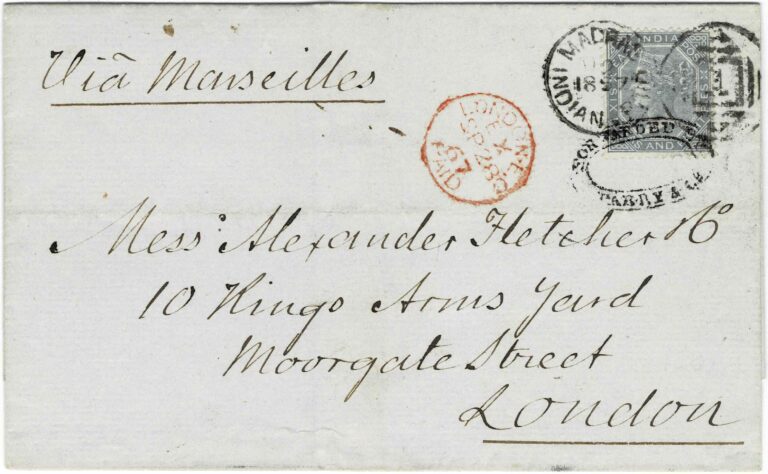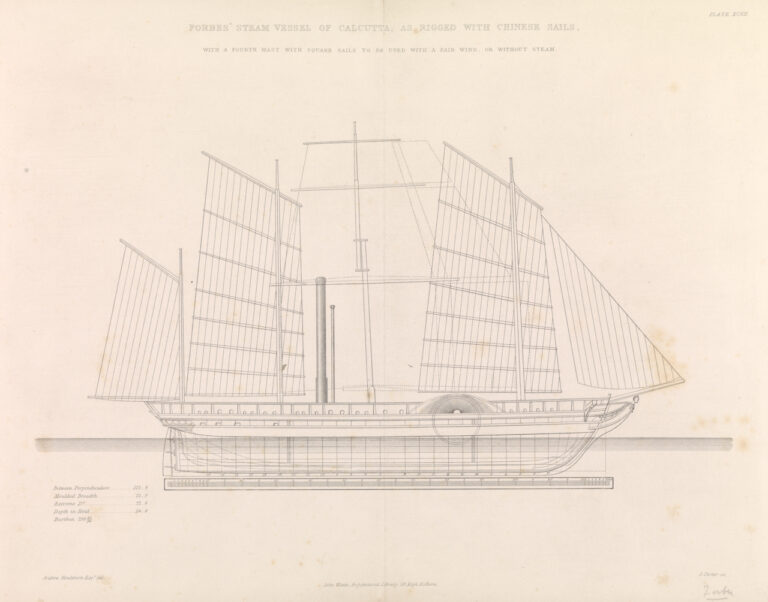Figure 1 shows both sides of a entire letter written in mid-1842 on board the ship ‘Rustomjee Cowasjee’, at anchor off “Rugged Islands” (Chusan, today’s Zhoushan Island) during the first Opium War.
Briefly, the East India Company was growing opium in India and dumping it in China. Opium was playing havoc with the Chinese – both economically and health-wise. In June 1839, the Chinese destroyed about 1,700 tons of opium triggering Great Britain into the usual imperialistic response. The war lasted three years until the Chinese were forced into the treaty of Nanking (or Nanjing).
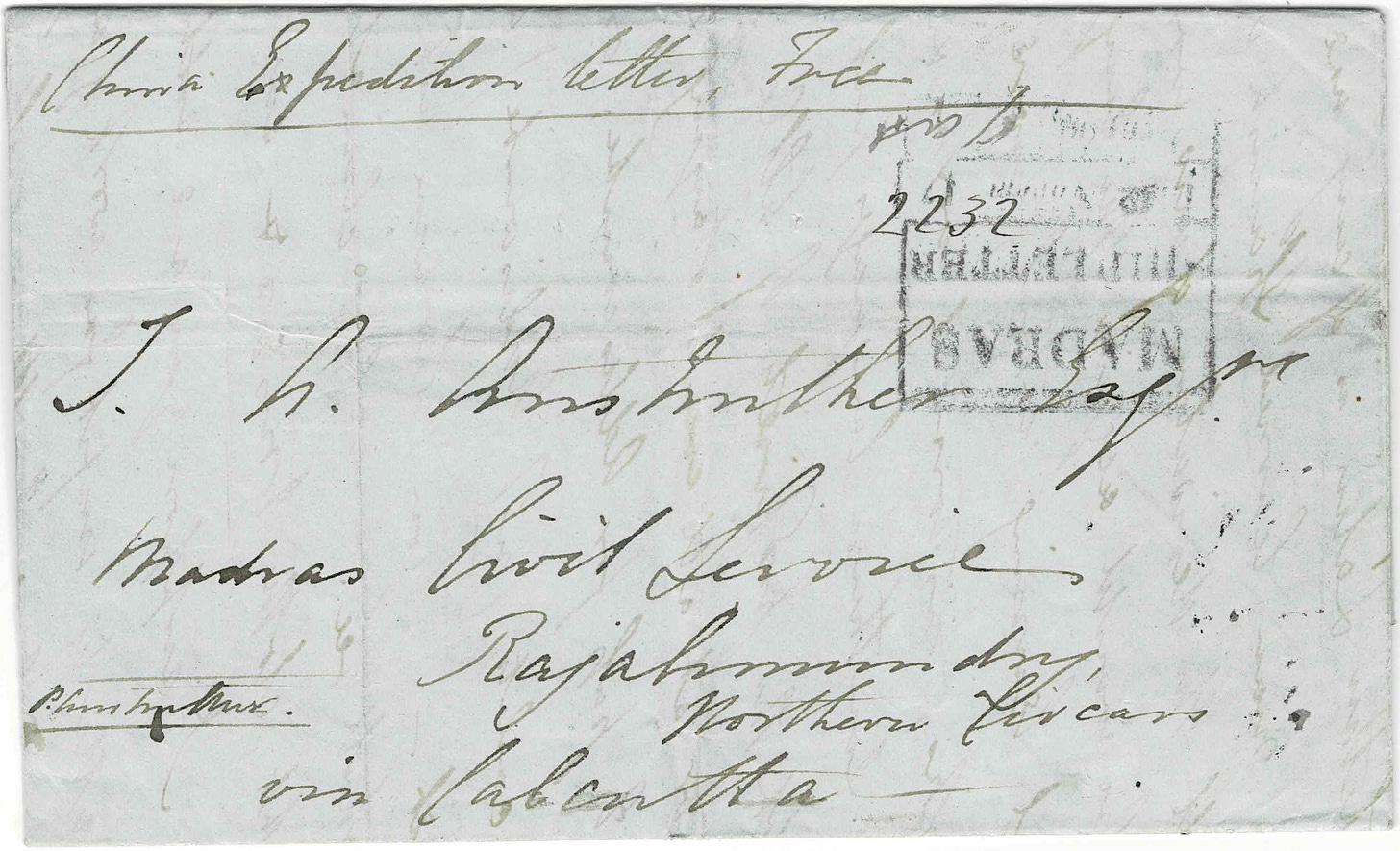
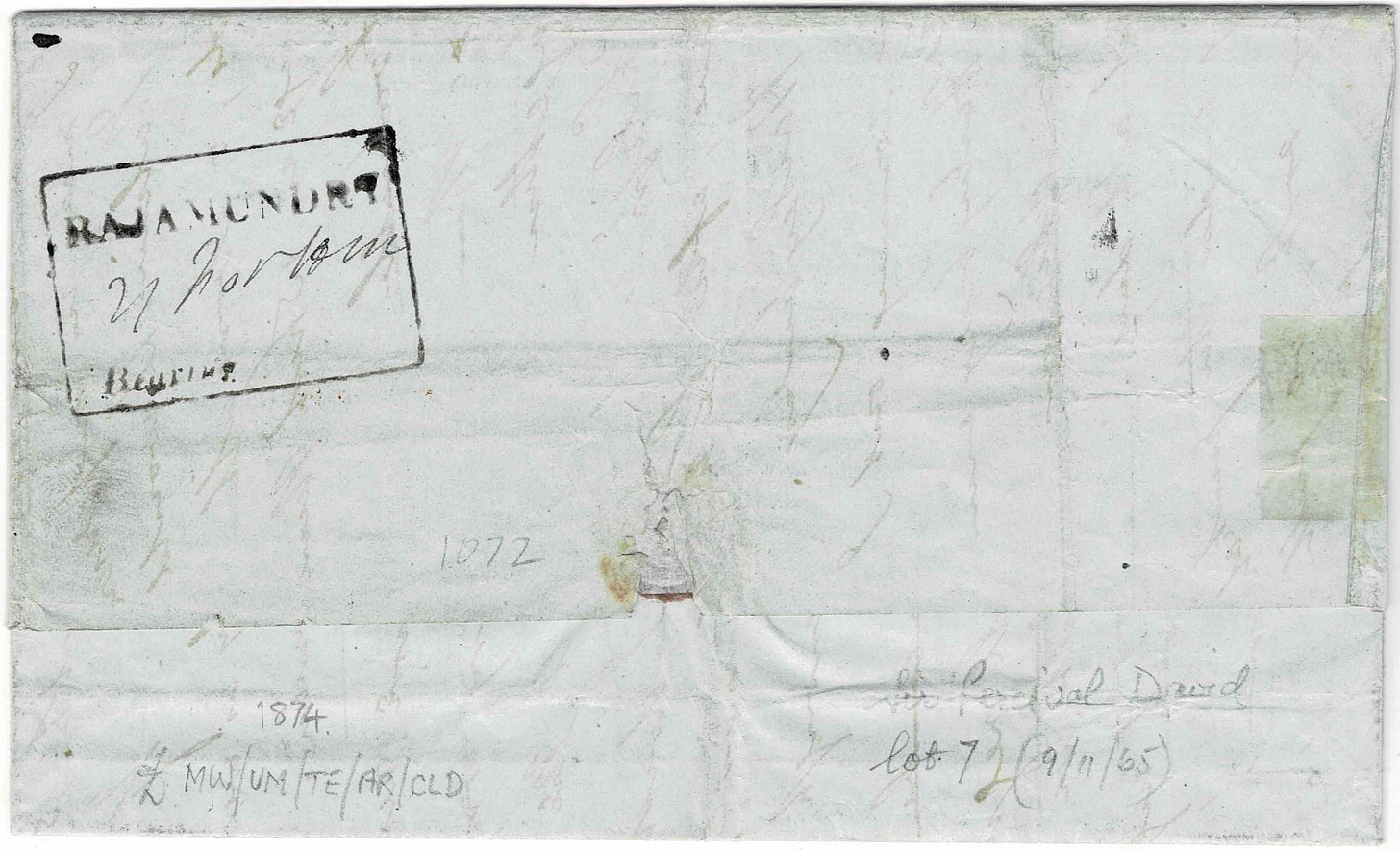
The letter, written about three months before the treaty of Nanjing is datelined June 4th. or 5th June 1842 (almost as if the writer had lost sense of time!) It was sent by Major Philip Anstruther to his younger brother, Thomas Andrew Anstruther, who was in the Madras Civil Service and stationed in the town of Rajamundry in Madras Presidency, India.
The letter is ex-Sir Percival David (1892-1964), a great China collector, and not just of its postage stamps and postal history, but also art and artifacts. It appeared as lot 7 in a Robson Lowe name sale on 9 November 1965 (this lot had other letters as well). I am unable to decipher the dealer’s (?) code ‘1874 / £ MW/UM/TE/AR/CLD’ on the rear left side; if anyone has a clue who the dealer was or can crack the code, please contact me (these codes are to be found in letters shown in Figure 2, 4, and 5 as well).
As often, I will first discuss various aspects of the letter’s postal history followed by some social / general history.
Postal History
Shipping Route
It can get difficult to say with certainty how the letter was routed from China to India. Shipping arrivals and departures in the west were comprehensively covered by Lloyd’s List and newspapers. However not necessarily so in the east. The Asiatic Journal and Monthly Register for British and Foreign India, China and Australasia (Vol XL, January-April 1843) shows that the ship Champion arrived at Madras on 17 November 1842 from Macao. Since the Madras handstamp is of the same date, I would think it is this ship which carried the letter to India.
Postage Rates
In early 1840, the British government decided to send an expeditionary force to China. In April, the Indian government issued the following order:
No. 294
To H. S. Oldfield, ESQ.,
Offg. Post Master General
Sir,
I am directed by the Right Hon’ble the Governor General in Council to instruct you to notify in the Calcutta Gazette and other usual channels of information, that Letters put into the Post Office at Calcutta, or sent post paid to Calcutta, or arriving from Europe or elsewhere beyond Sea, for the Officers and others of the Expedition to China, will be forwarded from Calcutta free of Postage, and that Letters addressed to Europe from the Officers and others of the Expedition will be transmitted by Ship, unless received into the Post Office of Calcutta through an Agent.
I have, & c.
G. A. Bushby
Secy. to the Govt. of India
Council Chamber, the 15th of April, 1840.
As instructed, the Post Master General issued a notification in the Calcutta Gazette dated 22 April and also annexed the above order.
POST OFFICE NOTICE
The Government of India has been pleased to direct that, all Letters for the Officers and others of the Expedition to China, shall be exempt from Postage, save only the Inland Postage upon such Letters as may be transmitted to Calcutta from Mofussil Stations. The subjoined copy of the Letter from the Secretary to the Government of India, communicating the orders of the Government, is published for general information.
H.S. Oldfield.
Offg. Post Master General
Fort William, Genl. Post Office,
the 20th April, 1840
To summarise, postage rates charged in India on letters to/from the expedition should have been as follows:
(a) Inland Postage in India
- Inland Postage from/to outstation locations to/from Calcutta (or Madras, in the case of the displayed letter) was chargeable
(b) Letters from China to India (and vice-versa)
- Outgoing ship postage (2 annas) on letters sent by officers in China (or by correspondents from India to such officers) was not chargeable
- Incoming ship postage (3 annas) on letters received by officers in China (or by persons in India from such officers) was not chargeable
(c) Letters from China to India to Europe (and vice-versa)
- Outgoing ship postage on letters to Europe from India on sailing ships (via the Cape) was not chargeable
- Incoming ship postage on letters into India from Europe on sailing ships (via the Cape) was not chargeable
- Steam postage on letters going to Europe (but not GB, since steam postage on such letters could not be prepaid in India then) on packet steamers was chargeable
- Steam postage on letters from Europe (but not GB) was perhaps chargeable
‘Free’ not applicable to India letters?
Getting back to Figure 1, the letter was sent from China to Madras (and not to Calcutta despite the ‘via Calcutta’ endorsement front bottom) as can be evidenced from the MADRAS / SHIP LETTER handstamp. Manuscript ‘9 as’ noted inside the stamp shows that the letter was dispatched bearing 9 annas to Rajamundry. This can be bifurcated as:
- 3 annas incoming ship postage (on letters up to 3 tolas weight) plus
- 6 annas inland postage from Madras to Rajamundry (distance 300-400 miles and weighing between 1/4th and 1 tola)
While the sender was likely not charged outgoing ship postage in China (see Figure 2 as well), it is strange that incoming ship postage in India was taken despite the government order and subsequent post office notification. The sender endorsed the letter ‘China Expedition letter Free’ but it was ignored!
He was not the only one so disregarded.
Scamp (1986 p. 169-70) shows a letter sent from ‘Camp near Ting-Lai-Lien-Choosan’ to Calcutta in September 1840 (a different correspondence) which appeared in the famous Ryohei Ishikawa auction in 1980. The recipient was charged 4 annas i.e. 3 annas incoming ship postage and 1 anna for inland delivery (a letter with the same postage charge can be seen in Figure 9). He therefore theorises:
…the authorisation for free carriage of expeditionary forces mail between China and India applied only to that mail in transit to or “from Europe”…the privilege apparently not having been extended to mail sent only to India, from where most of the original force was conscripted.
(emphasis mine)
He also comments:
…the instructions to the forces in the field was unclear in this regard, since the letter was annotated “From Eastern Expedition”, the assumed sorting mechanism for determining which mail from China was not to be charged the Indian inward ship letter fee.
Looking at more Anstruther letters
In a couple of recent sales by Ava Auctions in Hong Kong, four letters from the same correspondence appeared. These are shown as Figures 2, 3, 4, and 5. All seem to have been routed via Madras and not Calcutta as one can’t see any Calcutta post office markings. All seem to have been charged incoming ship postage and inland postage, and in some cases, something more!
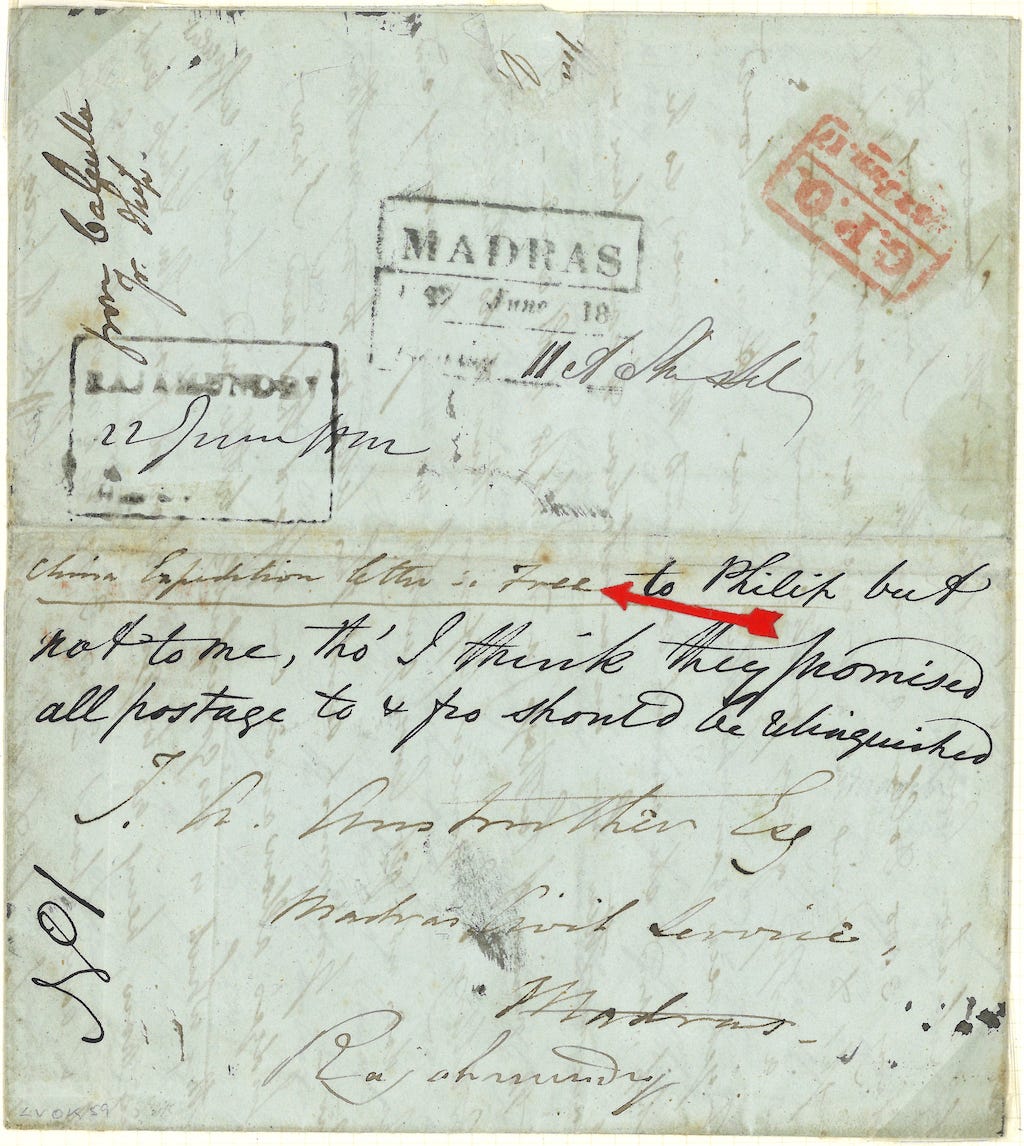
Figure 2 shows the endorsement ‘China Expedition letter Free’ made by the sender. In a different hand, likely that of the receiver, these words follow:
…to Philip but not to me, tho’ I think they promised all postage to & fro should be relinquished.
This indicates that the recipient knew that the sender was not charged any postage but for reasons he couldn’t comprehend, he was.
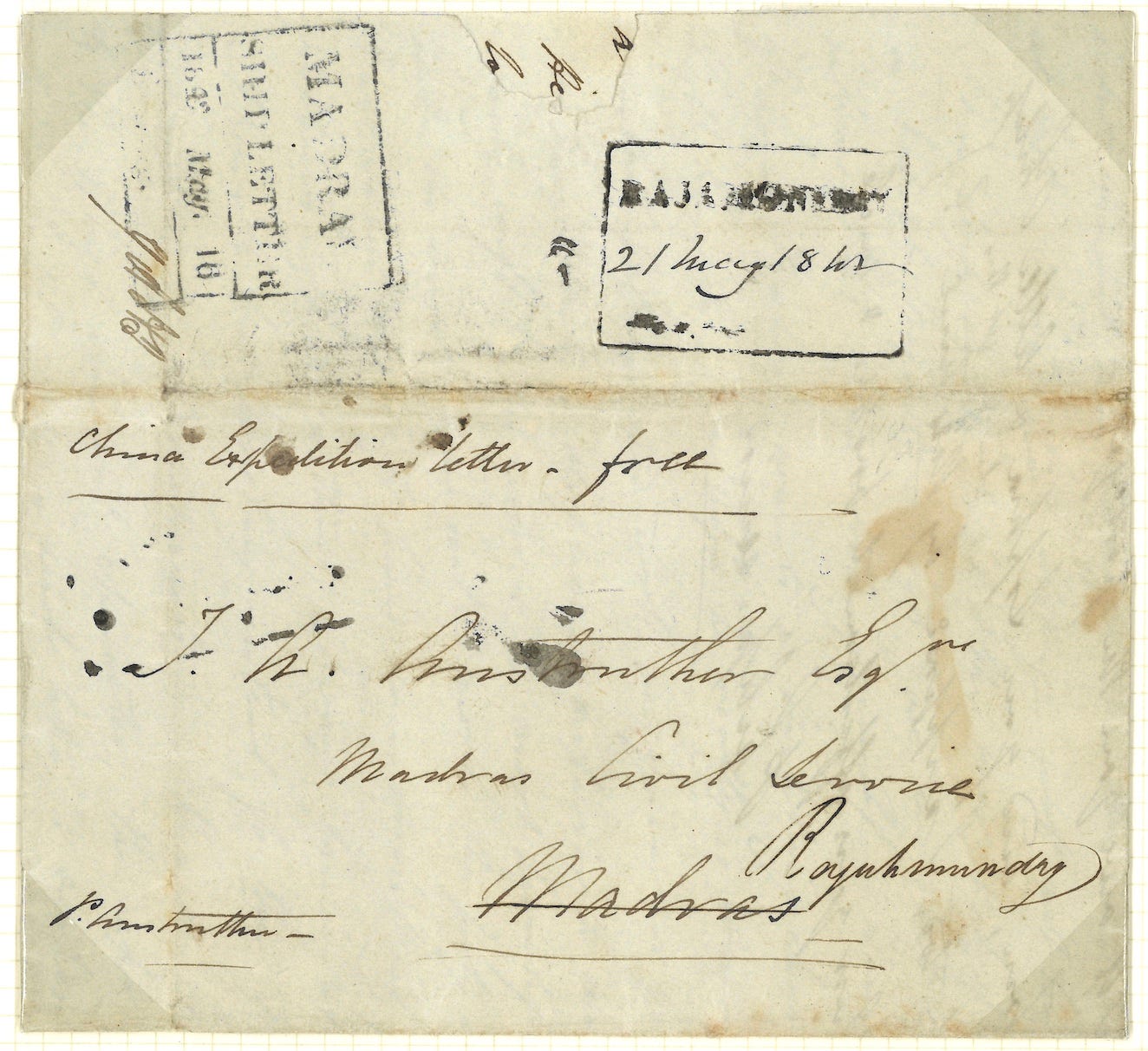

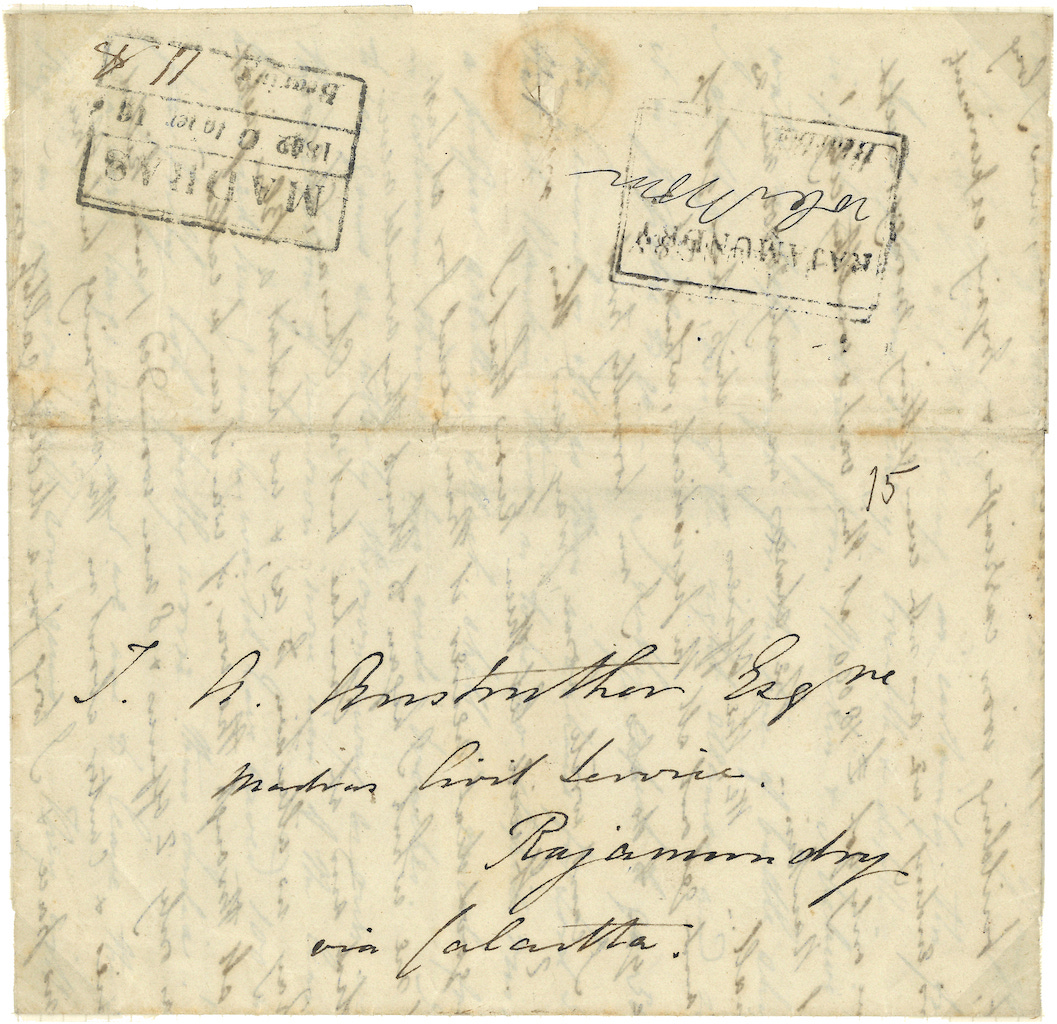
I have tabulated these five letters shows as Figures 1-5 (Figure 6) in order of date they were written.
As one can observe, the total postage charged in India varied between 8 and 11 annas.
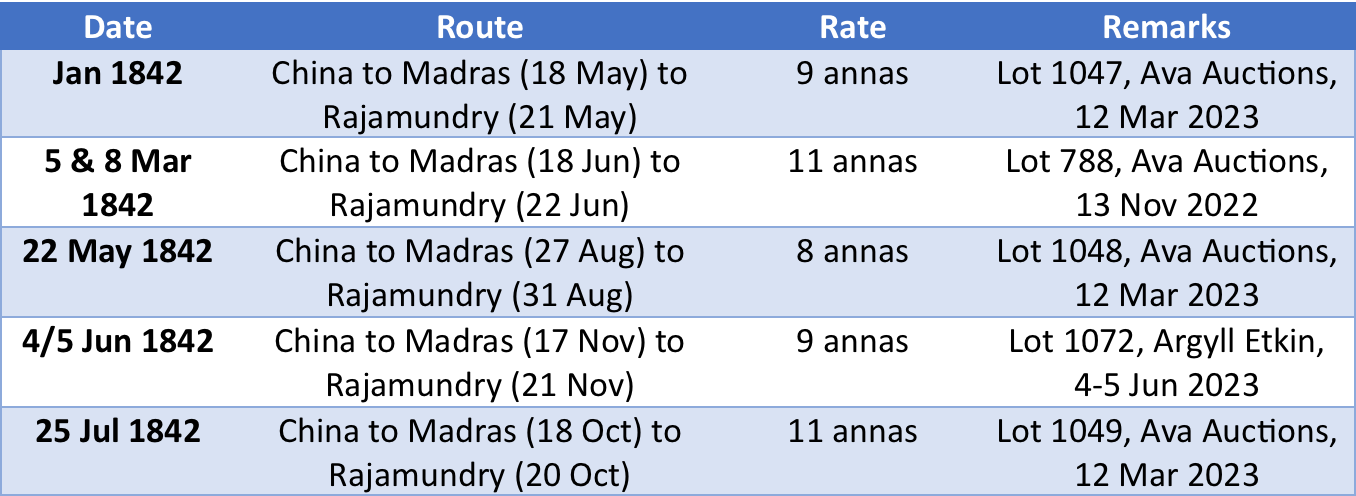
If we accept the theory that incoming ship postage was always to be charged on letters to India, 9 annas (3 annas ship plus 6 annas inland) would be the correct rate for all of them.
Then why was 11 annas, which seems to be inclusive of 2 annas outward ship postage from China, charged on a couple of occasions? Why the charge of 8 annas on one? Was the Madras post office as confused over the China Expedition letter charges as the recipients were?
Letters from other Correspondences
To be sure, Ava Auctions sold a couple of other similar letters but from a different correspondence. One (lot 792 in the November 2022 auction) was sent to Palavaram (a few miles outside Madras) via Calcutta (Figure 7). It seems to have been carried privately or under cover from China and then put into the post by an agent or friend. Why do I say this? Because no ship letter handstamp can be seen applied; and further, the letter pays, in Calcutta, only the inland postage of 6 anna postage (900-1100 miles and weighing up to 1/4th tola).
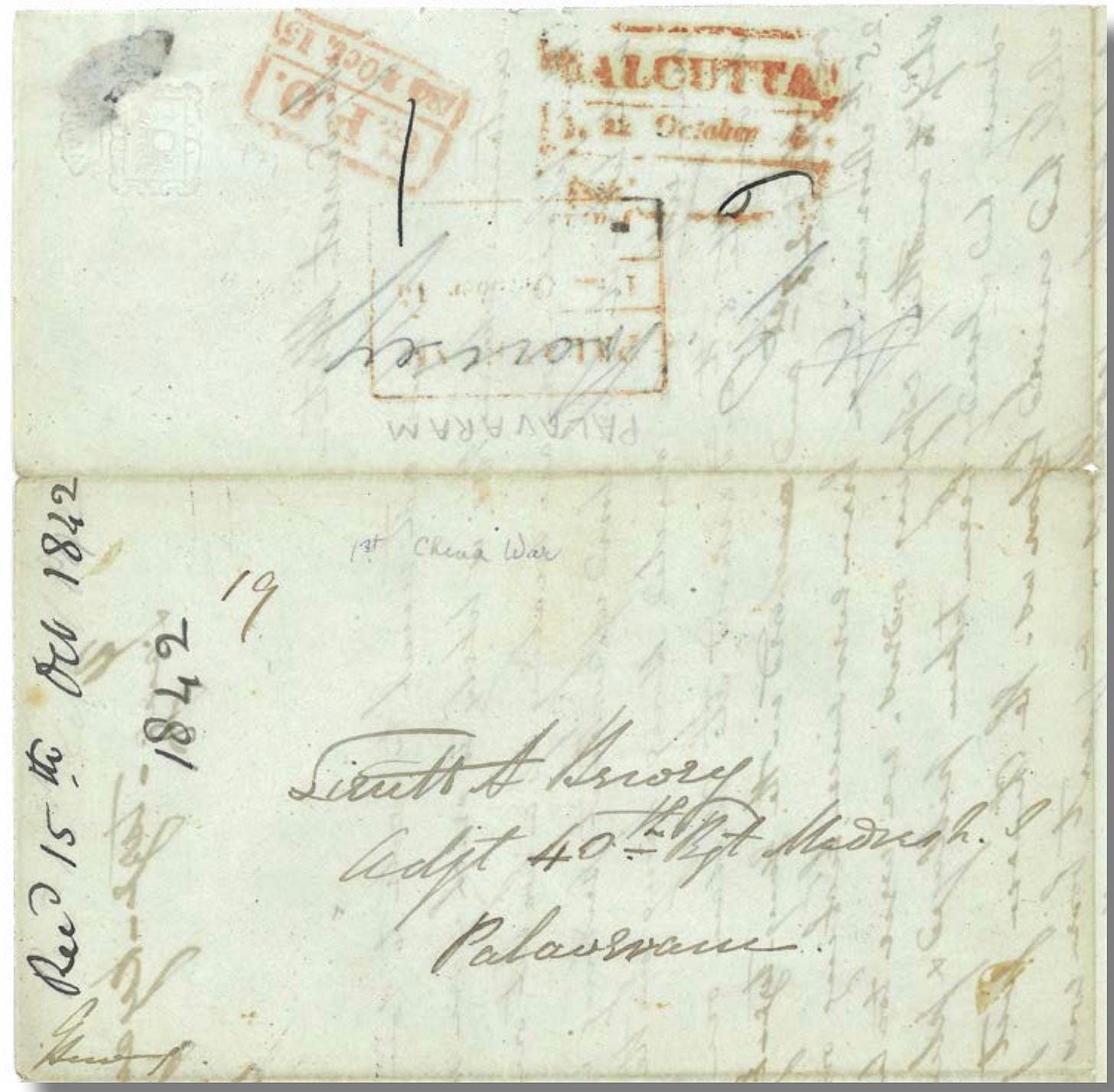
The other (lot 803 in the same auction), again to Palavaram via Calcutta, was charged 15 annas with the manuscript ‘S & I’ (ship & inland) below it (Figure 8). This would be 12 annas inland postage (900-1100 miles and weighing 1/4th to 1 tola) plus 3 annas incoming ship postage.
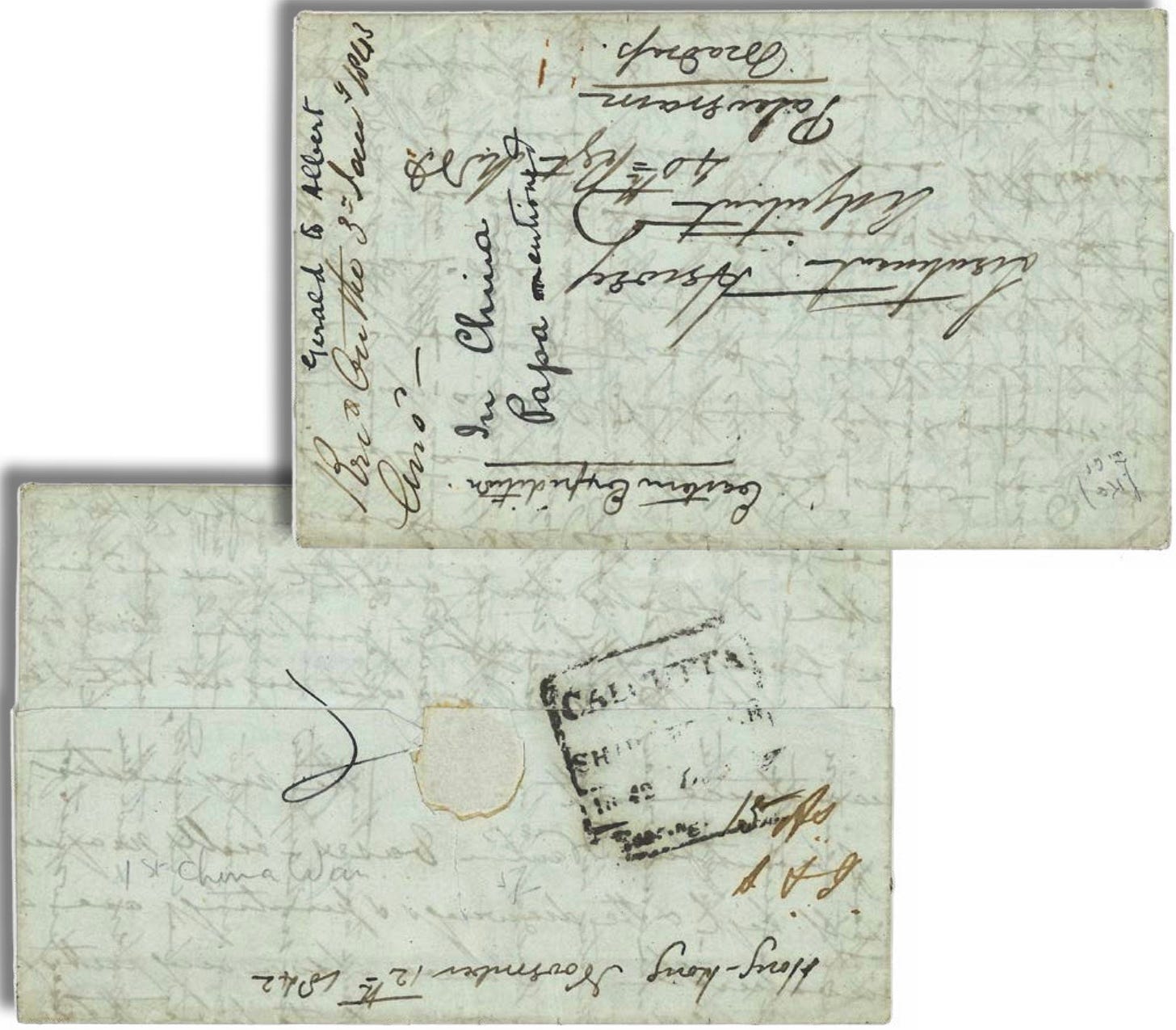
When I requested Andrew Cheung, a well-known Hong Kong collector and expert, for his views on this article, he showed me a couple of other letters. His first one was written 22 December 1840 and arrived at Calcutta 9 February 1841 (Figure 9). A postage due of 4 annas i.e. 3 annas incoming ship postage plus 1 anna local delivery is marked on it.
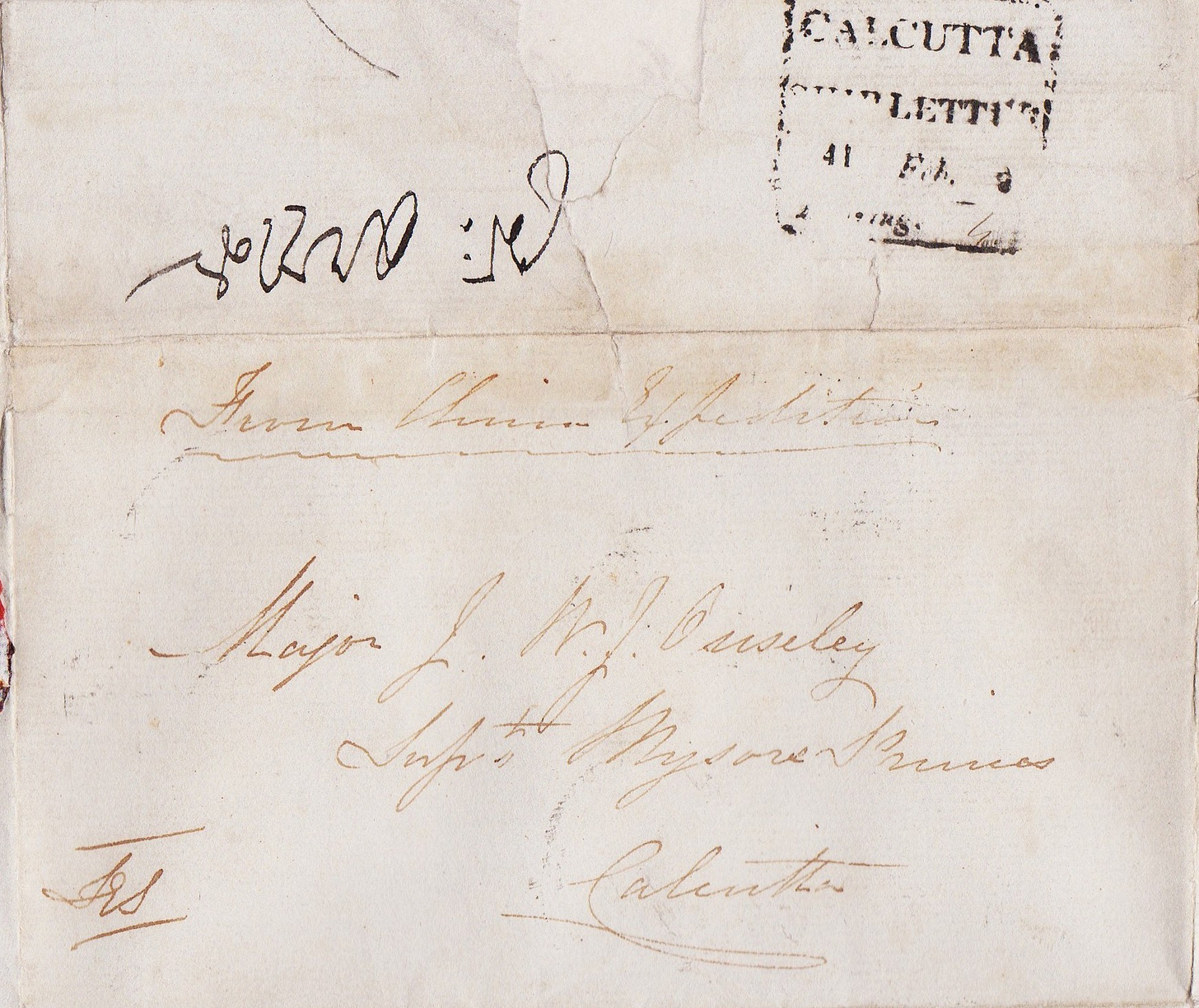
All these examples, albeit few, indicate that incoming ship postage on letters delivered within India was indeed charged by the Indian post office. On most occasions.
There exists one exception at least. Andrew also showed me an Anstruther letter written 18 March 1841 (just after his release) on which the Madras post office did not charge any incoming ship postage but just the inland postage (Figure 10) of 2 annas. They seem to have got it right for once!
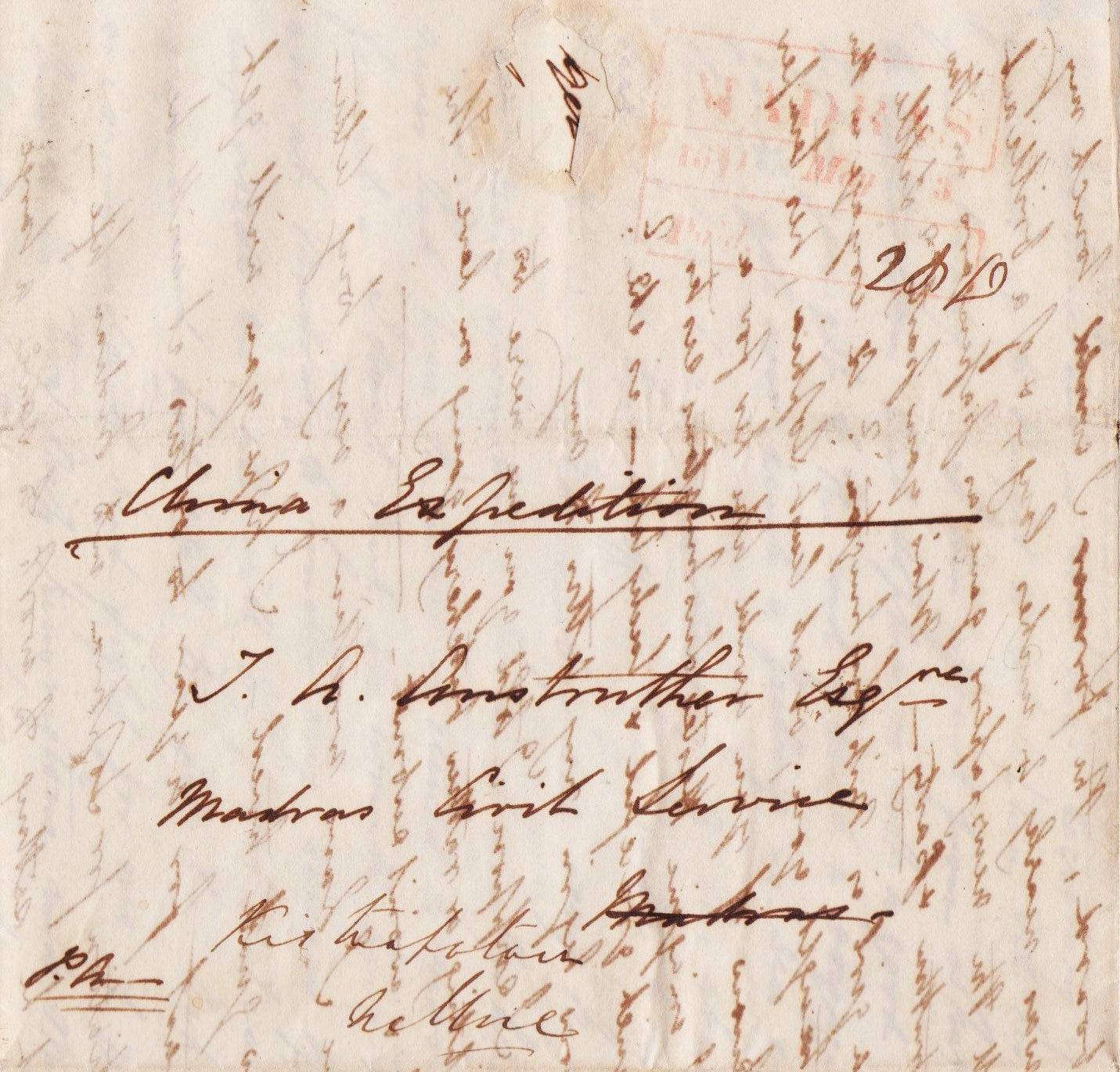
Now that we have whetted the postal historian’s appetite, we will try to try to do the same to the social / general historian!
Anstruther and his China adventure
Philip Anstruther was born on 12 September 1807 and was the second son of Sir Alexander Anstruther (1769-1819), 3rd Baronet of Balcaskie, Fife, Scotland. He was commissioned lieutenant in the Madras Horse Artillery on 19 June 1824.
The first Opium War broke out in 1839. Anstruther sailed to China in command of the detachment of Madras Artillery but was taken prisoner on 16 September 1840 (more on this later). Later, he served in the war in the Punjaub and the Expedition to Burmah 1853-54. He had medals for his service in the Cape, China, Punjaub, and Burmah. In December 1842 he was appointed Companion of the Order of the Bath. In 1858 he retired with the rank of Major-General. He never married and died on 18 February 1884.
Captured and Caged
On 16 September 1840, Anstruther was captured by the Chinese when he was out on a survey in the neighborhood of Tinghai, the chief town of Chusan. For the first few days, perhaps a couple of weeks, he and other English captives were confined in cages made of wooden bars. While they were allowed to take exercises at regular intervals during the mornings, they were locked up at nights.
The first account of Anstruther’s captivity seems to have been written in a letter to his friends at Chusan which was published in MacPherson (1840). Another account appears in Conolly (1869 pp.44-46) and an abbreviated version in Anstruther (1923 pp. 60-62). I summarise from these sources (though the accounts don’t always agree with each other).
…he went down a pass past a joss-house (a Chinese temple) where thick trees overhung the narrow path on both sides, making it quite dark. On getting to the other end of the grove he became aware that he was being followed by a crowd of Chinamen. A Chinese soldier rushed out and struck at his old Lascar, the only man with him, with a hoe. Captain Anstruther met the soldier and drove him back, but a number of the other Chinese charged them with double-pronged spears, and there was nothing for it but to run.
Meantime the whole population of the valley gathered with loud shouts in their front. His Lascar was struck down, and was pounded to death with stones, and he himself was beaten down. His hands and feet were tied, he was gagged, put in a palanquin, and hurried off to the village. At midnight a chain was put round his neck, and he was forced to walk all that night and the next day, in spite of the injuries he had received, and was then taken by boat to Ningpo. He was there fed and put in prison, where he was forced to get into a cage with wooden bars one yard long, one yard high, and two feet wide. An iron ring was put round his neck, and his hands put in handcuffs locked to a stick about one foot long which was fastened to the ring about his neck. Irons weighing about 18 lb were also put on him. These he wore for four weeks.
About a week later he met several other prisoners taken from the shipwreck of their vessel, The Kite. One of them was Lieutenant C. H. Douglas, R.N. and a nephew of Mr. Douglas of Fife (“Is it not wonderful how Fife folk meet in all places and in the most unexpected situations?”) The other was Mrs. Noble, wife of Captain John Noble of The Kite; the Captain and their son had both been lost in the wreck. Even Mrs. Noble was not spared the cage (Figure 11).
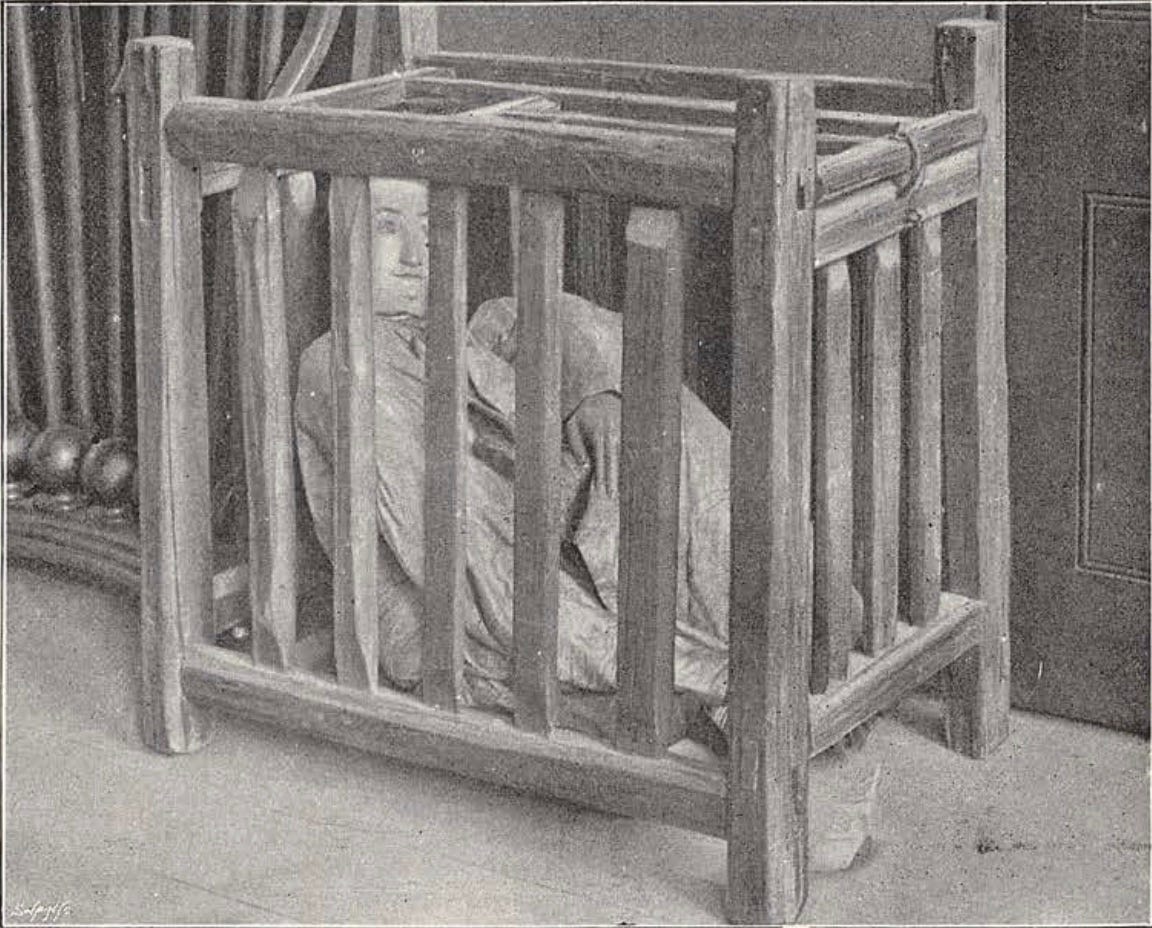
Even in his “horrid little cage”, Anstruther indulged in his taste of drawing. He was frequently taken to the magistrates who inquired about British steamers. He drew for them a map of Chusan Bay, town, and suburb, with ships and tents. This earned him a good dinner and some hot water to wash his blood and dirt. On another occasion, he drew a map of London with “Westminster Abbey, St Paul’s, Windsor Castle, and Buckingham Palace all pleasantly situated in a Park, with Grosvenor Place very well situated for viewing all four.” On yet another occasion, he draw a map of England “showing mail-coaches and cattle somewhat larger than cities and towns.” His artworks got him into a bigger cage three foot six inches by two foot one inch!
After a few days of suffering, the prisoners were taken out of the cages and lodged in temples in different parts of the Ningpo. After the Chinese and Britain had come to terms, on 22 February 1841, 14 prisoners including Anstruther, Douglas, and Mrs. Noble, were taken on palankins to the port of Chinhai. Four days later, they were on board the HMS Blonde in the harbour of Chusan. Their ordeal of more than five months was over.
And Captain Anstruther was quickly back on duty. He was made a major and had his eyes set on another promotion. In the letter pictured first he writes:
We are all terribly disgusted at getting no more brevets, poor Penn has commanded in three actions & failed in getting the majority which I got for one. If they don’t give me the Lieut. Colonelcy as they did Knowles the majority is useless & C.B a mockery…we are furious about our prize money being so infamously stolen from us…
Anstruther or Douglas?
On the internet, one finds drawings / paintings purporting to be that of Anstruther in his cage (Figure 12). Was this really him?
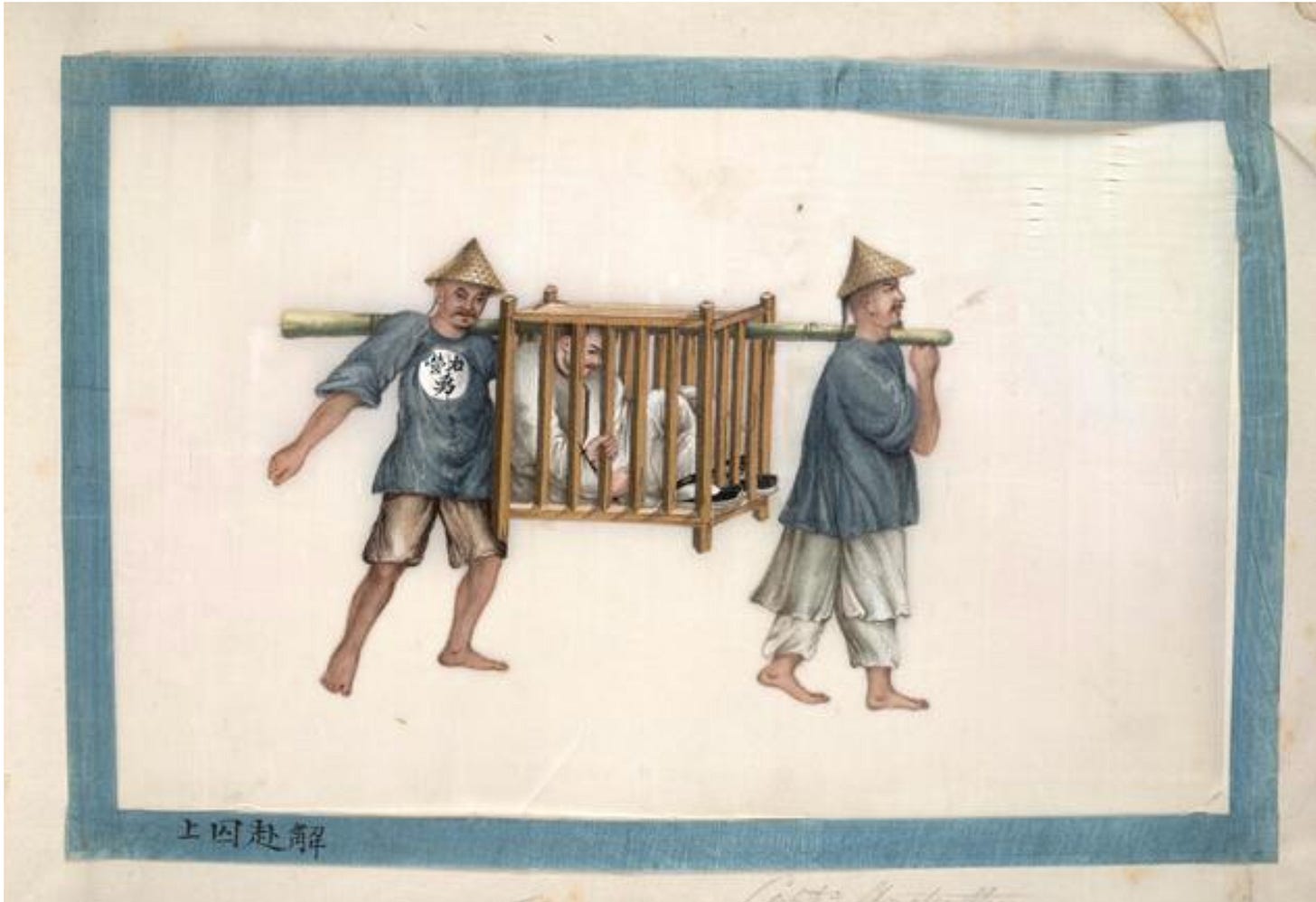
The description accompanying Figure 12 (click the link) states:
Captain Anstruther. Album containing 12 paintings illustrating Chinese. 1840 – 1860. Capt. Anstruther. Transporting from and to prison’…Gouache on pith paper. China/Canton style. Image taken from Album containing 12 paintings illustrating Chinese punishments. Hastings Albums. Originally published/produced in 1840 – 1860. . Source: Add.Or.5189,. Lang
If one looks closely at the bottom of the painting (Figure 13), one can see the words written in pencil:
Capt. Anstruther. Transporting from and to prison.
Does this mean that the drawing depicts Anstruther? Or does it mean that it was drawn by Anstruther?

In Conolly (1869), after page 45, one can see a similar (redrawn?) plate which states: “Captain Philip Anstruther, Prisoner in China 1840” (Figure 14).
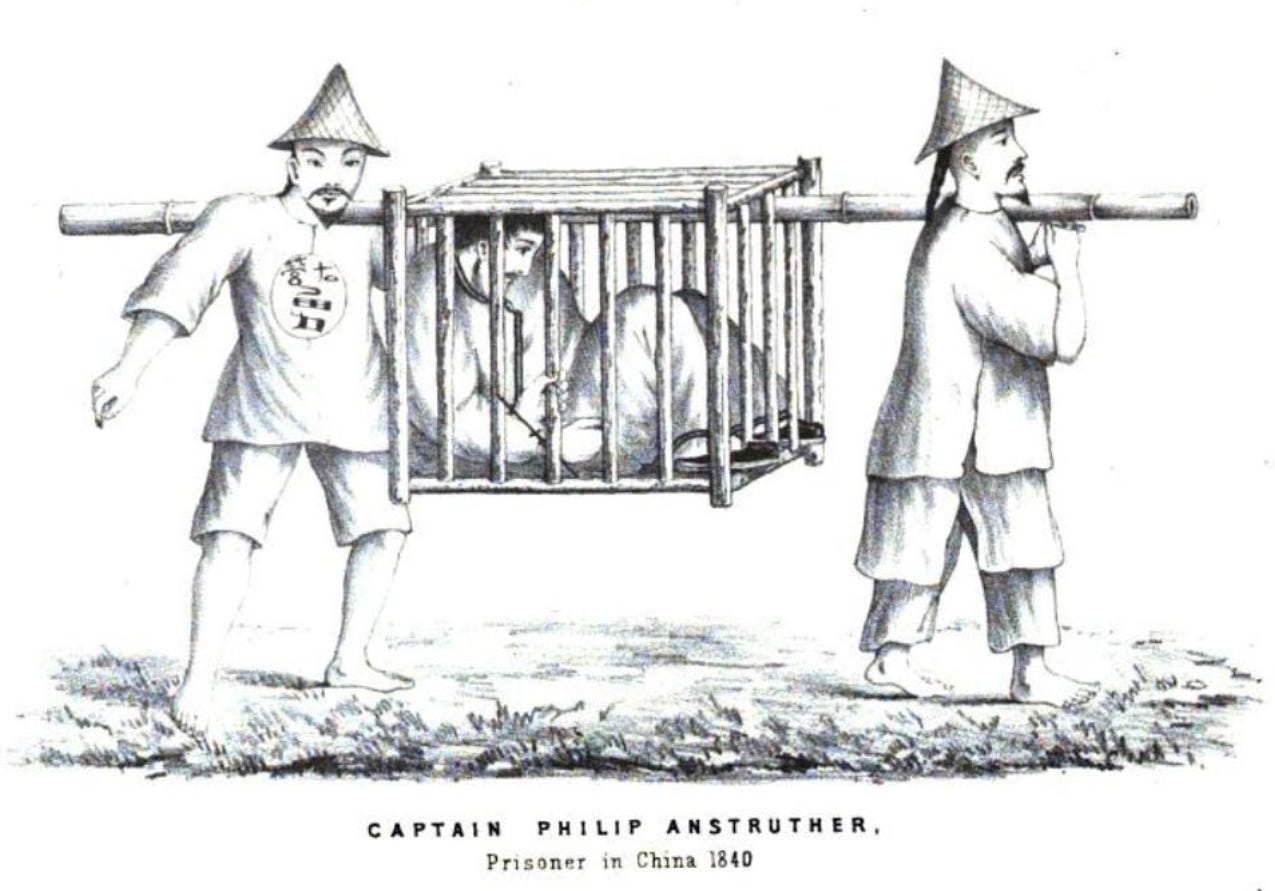
The Royal Museums, Greenwich has a related item in their collection (Figure 15).
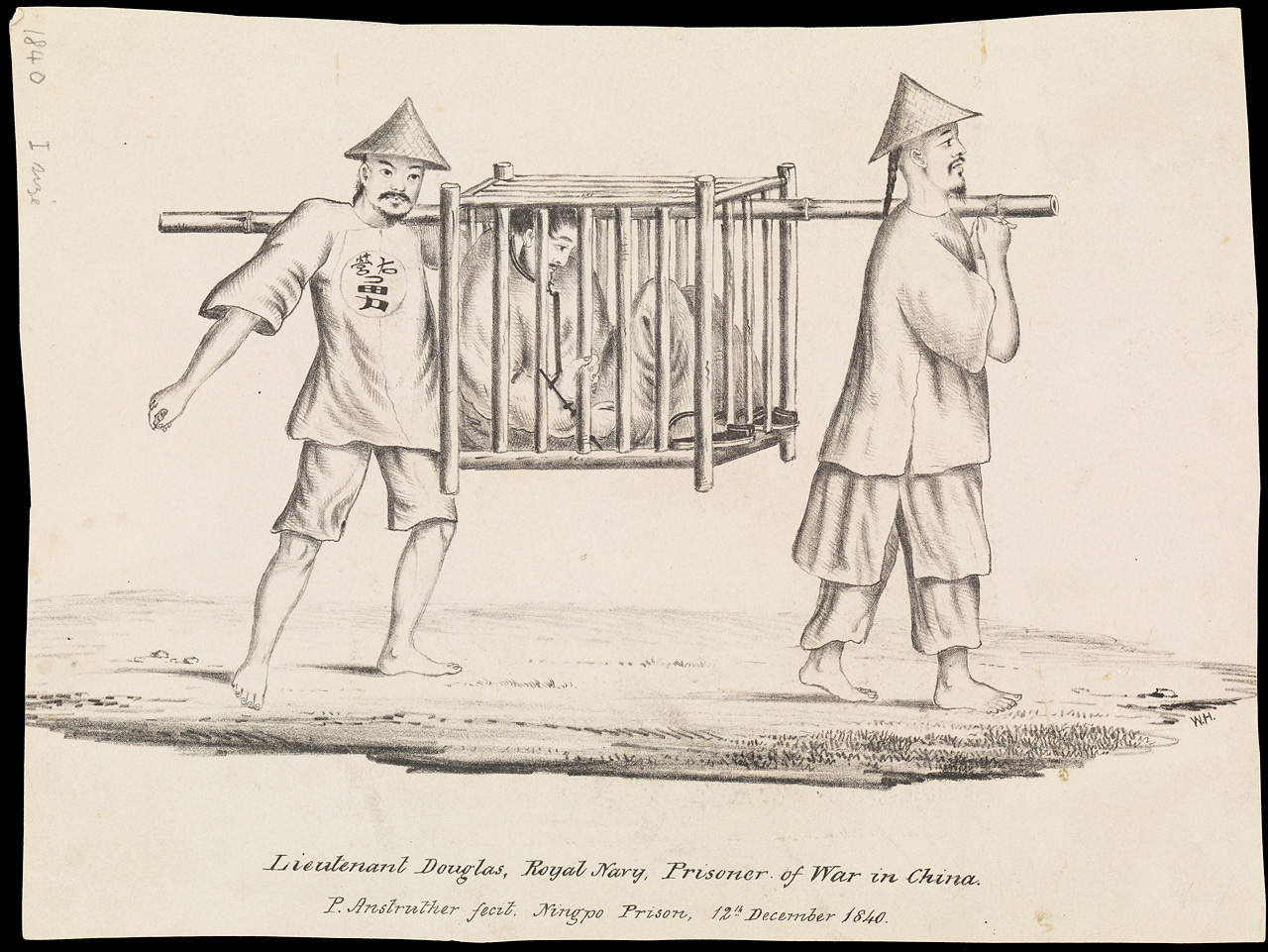
The museum’s description states that the person in the cage is Lieutenant Douglas and not Anstruther himself.
Given that it was Anstruther who was known to be the accomplished artist, I believe it is Lieutenant Douglas who is in the cage.
Cage caged!
Anstruther took his cage with him as a souvenir when he returned to Madras. It is displayed there at the Fort St. George Museum; appropriately behind another cage, this one of glass! (Figure 16)
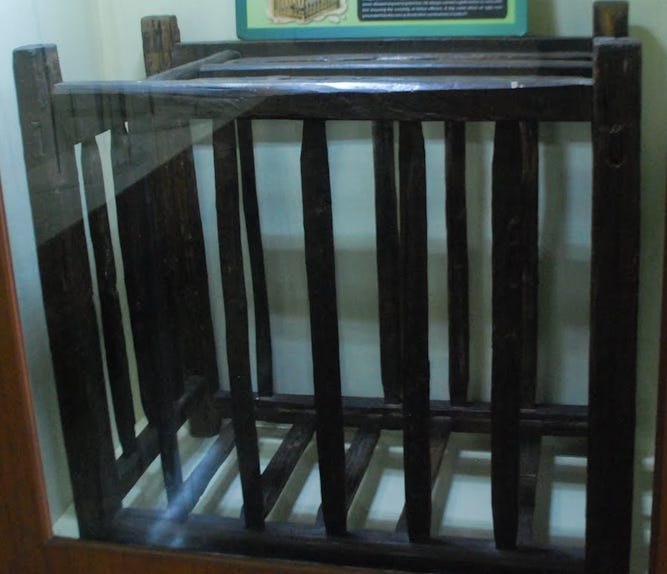
The display (Figure 17) describing the cage contains information that we have noted before. It also shows a self-portrait of Anstruther.
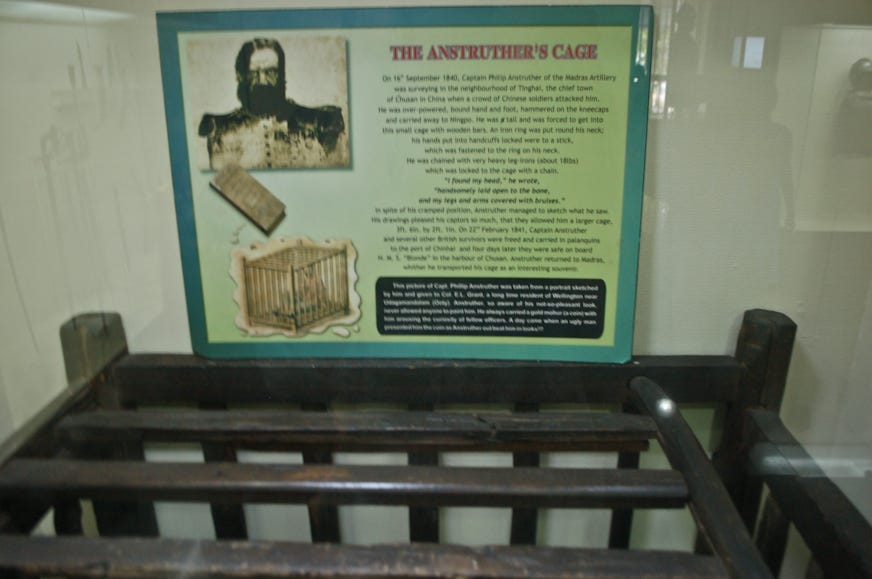
In an online blog, written by somebody who visited the museum and took these photographs, is mentioned an event, apocryphal or not, but interesting enough:
Anstruther was no likely candidate for a beauty show, His shaggy hair and beard were of a fine rufus red. Instead of being flattered, so he avowed, he would not permit any one even to sketch his portrait but he did paint one of himself. For some time he aroused the curiosity of his brother officers by always carrying a gold mohur (coin) in his pocket. The purpose of which one day he disclosed in the officers’ mess. A stranger entered and Anstruther, walking up to him gave him a hearty slap on the back and said “By God, Sir you are uglier than I am. Here’s a gold mohur for you.”
The cage can be seen in this YouTube video of the Fort Museum at 2:15-2:16. Don’t blink or you will miss it!
Acknowledgements
Thanks to Max Smith and Andrew Cheung. Comments and feedback are always welcome and can be sent to my email address: abbh [at] hotmail [dot] com.
References
- Anstruther, A[rthur]. W[wllesley]. History of the family of Anstruther. Edinburgh and London: William Blackwood and Sons, 1923
- Conolly, M[atthew]. F[orster]. Fifiana: Or, Memorials of the East of Fife. Glasgow: John Tweed, 1869
- Lane-Poole, Stanley. “Caged in China.” The English Illustrated Magazine. Issue 134 (November 1894). Available on https://www.victorianvoices.net/ARTICLES/EM/EM1895A/EM1895A-Cages.pdf; accessed 1 June 2023.
- MacPherson, D[uncan]. Two Years in China: Narrative of the Chinese Expedition, from Its Formation in April, 1840, Till April, 1842. London: Saunders and Otley, 1842
- Scamp, Lee C. Postal Rate History of China and Hong Kong. The Pre-Adhesive Period to the Beginning of Packet Service from HongKong 1800-1845. Houston?: Nancol Enterprises, Inc. with assistance from the Texas Philatelic Foundation, 1986.
Web Sources (all accessed 1 June 2023)
- https://www.rmg.co.uk/collections/objects/rmgc-object-107648
- http://samilitaryhistory.org/vol045rc.html
- https://noshellfishblog.wordpress.com/2016/09/23/15-why-you-should-practise-your-drawing
- https://www.alamy.com/captain-anstruther-album-containing-12-paintings-illustrating-chinese-1840-1860-capt-anstruther-transporting-from-and-to-prison-in-a-wooden-cage-capt-philip-anstruther-1807-84-was-in-charge-of-a-detachment-of-madras-artillery-in-the-anglo-chinese-war-of-1840-41-he-was-captured-by-the-chinese-on-15th-september-1840-and-transported-about-the-country-in-a-wooden-cage-gouache-on-pith-paper-chinacanton-style-image-taken-from-album-containing-12-paintings-illustrating-chinese-punishments-hastings-albums-originally-publishedproduced-in-1840-1860-source-addor5189-lang-image227214246.html?imageid=6DFF022D-7FDA-40B7-BE99-08986110A83F&p=1811172&pn=1&searchId=ff0fdbcfad64ee5b215801738a6c821b&searchtype=0

